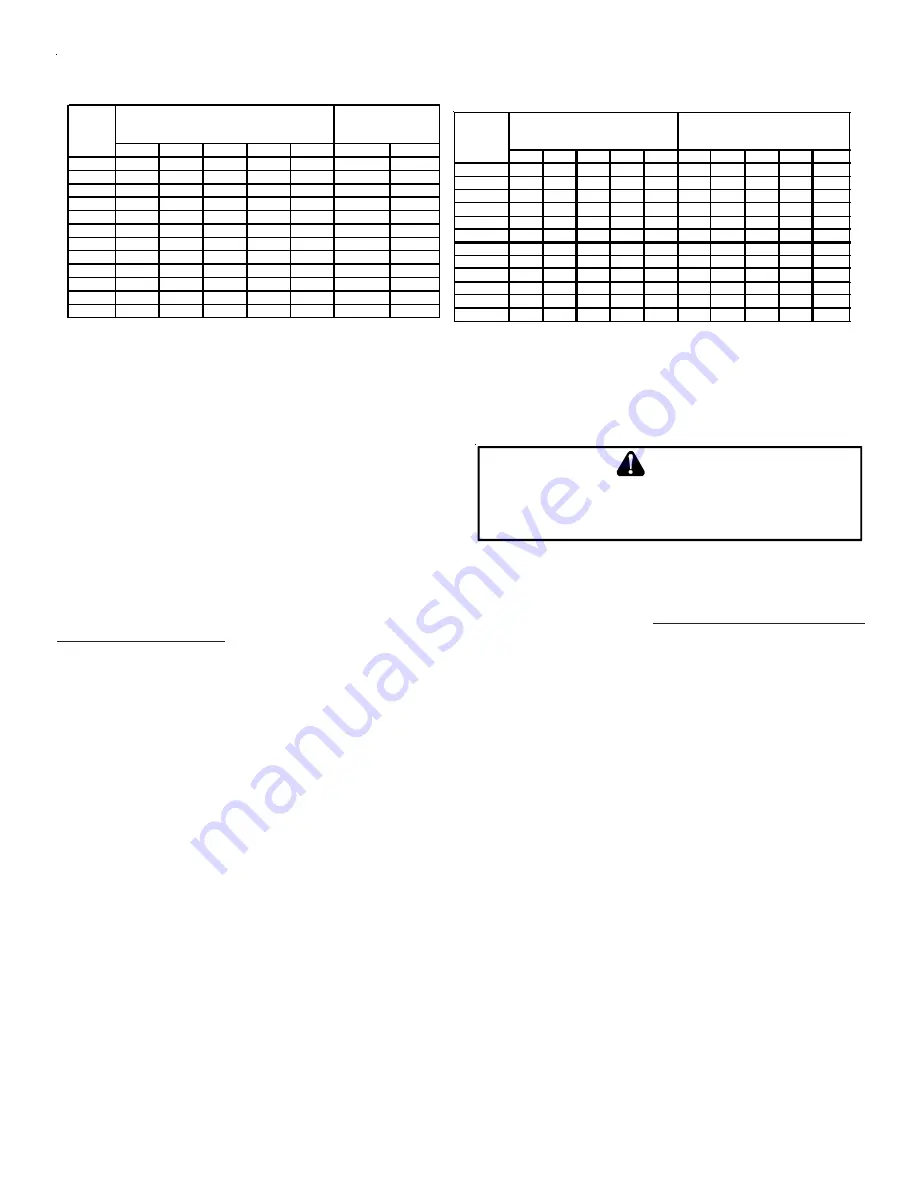
29
C
IRCULATING
A
IR
& F
ILTERS
D
UCT
WORK
- A
IR
F
LOW
Duct systems and register sizes must be properly designed for the
CFM and external static pressure rating of the furnace. Design the
ductwork in accordance with the recommended methods of “Air
Conditioning Contractors of America” Manual D.
Install the duct system in accordance with Standards of the National Board of Fire Underwriters for the Installation of Air Conditioning,
Warm Air Heating and Ventilating Systems. Pamphlets No. 90A and 90B.
A closed return duct system must be used, with the return duct connected to the furnace.
NOTE:
Ductwork must never be attached
to the back of the furnace.
For upflow installations requiring 1800 CFM or more, use either two side returns or bottom return or a
combination of side /bottom. Flexible joints may be used for supply and return connections to reduce noise transmission. To prevent
the blower from interfering with combustion air or draft when a central return is used, a connecting duct must be installed between
the unit and the utility room wall. Never use a room, closet, or alcove as a return air chamber.
C
HECKING
D
UCT
S
TATIC
Refer to your furnace rating plate for the maximum ESP (external duct static) rating.
Total external static refers to everything external to the furnace cabinet. Cooling coils, filters, ducts, grilles, registers must
all be considered when reading your total external static pressure. The supply duct pressure must be read between the
furnace and the cooling coil. This reading is usually taken by removing the “A” shaped block off plate from the end on the
coil; drilling a test hole in it and reinstalling the block off plate. Take a duct static reading at the test hole. Tape up the test
hole after your test is complete. The negative pressure must be read between the filter and the furnace blower.
Too much external static pressure will result in insufficient air that can cause excessive temperature rise. This can cause
limit switch tripping and heat exchanger failure.
To determine total external duct static pressure, proceed as follows;
1. With clean filters in the furnace, use a draft gauge (inclined manometer) to measure the static pressure of the return
duct at the inlet of the furnace. (Negative Pressure)
2. Measure the static pressure of the supply duct. (Positive Pressure)
3. The difference between the two numbers is .4” w.c.
3/8"
1/2"
5/8"
3/4"
7 /8"
1/2"
3/4"
1"
1- 1/4" 1- 1/2"
10
39
92
199
3 29
501
275
567
1,07 1
2,205
3,307
20
26
62
131
2 16
346
189
393
732
1,496
2,299
30
21
50
107
1 81
277
152
315
590
1,212
1,858
40
19
41
90
1 45
233
129
267
504
1,039
1,559
50
18
37
79
1 31
198
114
237
448
913
1,417
60
16
35
72
1 21
187
103
217
409
834
1,275
80
13
29
62
1 04
155
89
185
346
724
1,066
100
11
26
55
9 0
138
78
162
307
630
976
125
10
24
48
8 1
122
69
146
275
567
866
150
9
21
43
7 2
109
63
132
252
511
787
200
8
19
39
6 6
100
54
112
209
439
665
250
8
17
36
6 0
93
48
100
185
390
590
T ub ing S iz e, O .D. T yp e L
Nom inal P ipe Siz e
S chedu le 40
Pip e o r
Tu bin g
Len gt h
F eet
*Data in ac cor danc e wit h NFP A pam phl et No. 54
Propane Gas Piping Chart II
Sizing Between Second or Second Stage Regulator & Appliance*
Maximum Propane Capacities listed are based on 1/2” W.C. pressure drop at 11” W.C. setting.
Capacities in 1,000 BTU/hour.
3/8"
1/2"
5/8"
3/4"
7/8"
1/2"
3/4"
10
730
1,700
3,200
5,300
8,300
3,200
7,500
20
500
1,100
220
3,700
5,800
2,200
4,200
30
400
920
2,000
2,900
4,700
1,800
4,000
40
370
850
1,700
2,700
4,100
1,600
3,700
50
330
770
1,500
2,400
3,700
1,500
3,400
60
300
700
1,300
2,200
3,300
1,300
3,100
80
260
610
1,200
1,900
2,900
1,200
2,600
100
220
540
1,000
1,700
2,600
1,000
2,300
125
200
490
900
1,400
2,300
900
2,100
150
190
430
830
1,300
2,100
830
1,900
175
170
400
780
1,200
1,900
770
1,700
200
160
380
730
1,100
1,800
720
1,500
Pipe or
Tubing
Length
Feet
Tubing Size, O.D. Type L
Nominal Pipe Size
Schedule 40
Sizing Between First and Second Stage Regulator*
Maximum Propane Capacities listed are based on 2 psig pressure drop at 10 psig setting.
Capacities in 1,000 BTU/hour.
To convert to capacities at 15 psig settings - multiply by 1.130
To convert to capacities at 5 psig settings - multiply by 0.879
Propane Gas Piping Chart I
N
EVER
ALLOW
THE
PRODUCTS
OF
COMBUSTION
,
INCLUDING
CARBON
MONOXIDE
,
TO
ENTER
THE
RETURN
DUCT
WORK
OR
CIRCULATION
AIR
SUPPLY
.
WARNING
Содержание *CSS9*
Страница 45: ...45 THIS PAGE LEFT INTENTIONALLY BLANK...






























